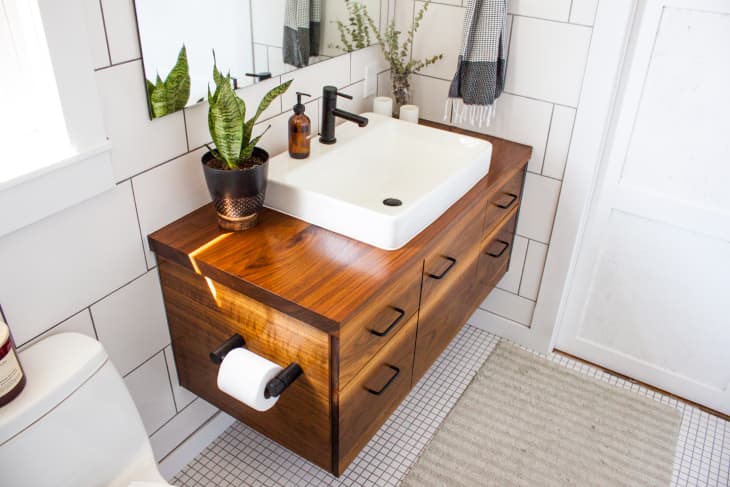Get Rid of Gnats in the Bathroom Once and for All with These Pro Tips

Having any infestation in your home is unsettling, whether you see tiny evidence of termites chewing on your decks or squirrels in your attic that keep you up at night with their scurrying. And even though they may not cause damage or health hazards in the same way as those two pests, having gnats in your bathroom buzzing around your head and landing on your toothbrush isn’t exactly a welcome sight, either.
Protecting your home from pests is essential to keep things functioning at their best, and the bathroom is an excellent room to start. As a place meant for getting clean and maintaining privacy, the last thing you need is unwanted guests, no matter their size. So, whether you have gnats in your bathroom now or want to prevent them from coming in the future, Apartment Therapy asked three experts to break it down so you can banish these pests once and for all.
What Are Bathroom Gnats?
Knowing what kind of tiny critters you’re dealing with is the first line of defense. “Generally, when we refer to gnats, we are talking about tiny flying insects,” says Natasha Kulinski of Beaver Pest Control.
Although several tiny bugs are called gnats, the term is often interchangeable with other types of flies, such as fruit flies and drain flies.
Sean Thomas, the editor of Conquer Critters, says that these bathroom gnats, typically found around water, are often called fungus gnats.
“In bathrooms, they tend to live in damp or wet areas like sinks, showers, toilets, and drains,” Thomas says. From water-filled toilets to post-shower steam, the well-hydrated spaces in bathrooms tend to attract bugs, and gnats are no exception.
Gnats vs. Fruit Flies vs. Drain Flies
Several different kinds of flies can appear in bathrooms, so how do you tell whether your tiny invaders are fruit flies, gnats, or drain flies? Thankfully, distinguishing between types isn’t as difficult as you might think. While they all share similarities, like their small size, some features can help you determine which is which.
Gnats
Gnats love damp places, so they thrive in bathrooms. “When it comes to looks, gnats tend to be darker and smooth,” says Thomas. Although fruit flies are also smooth, they appear lighter than actual gnats.
Fruit Flies
As their name indicates, fruit flies are attracted to organic matter, so they usually hang out in kitchens and other areas where you might store fruit.
“The most obvious difference is that fruit flies have red eyes,” says Kulinski. If fruit flies are in your bathroom, you should check for fruit remnants, such as a banana peel or apple core that may have been tossed into the wrong trash bin.
Drain Flies
To quickly identify drain flies, Thomas advises looking at the color. “Drain flies have a similar color to gnats but are fuzzy,” he says.
The name drain fly indicates where they are found: in and near drains. That’s because they breed in the organic matter inside the drain, such as hair.
How to Get Rid of Gnats in the Bathroom
The first step to ridding your bathroom of gnats is to address any areas holding moisture. “Fix any leaks and wipe up any water that you splash while getting out of the shower, brushing your teeth, and shaving,” recommends Thomas. He also advises turning on your bathroom fan to increase airflow.
Drains are a considerable insect breeding ground because of the moisture and organic matter lurking in the pipes. So, it’s essential to take good care of your drains by rinsing them regularly with hot water.
To kill and flush out insect eggs, Thomas suggests pouring vinegar down the drain, letting it sit for several minutes, and then following it with hot water.
How to Prevent Gnats in the Future
Arthur Katz of Knockout Pest Control says that flushing the drain is a good start, but taking it one step further can provide even more insurance to deter gnats.
“Perform a good cleaning of the drain cover by unscrewing and cleaning both sides and about a foot of the drain,” advises Katz. (This is also a great way to prevent drain flies, since it eliminates the organic matter that they use for breeding.)
Kulinski also recommends checking for leaks, as even slow leaks can attract pests when water sticks around. “We often find homes that have a leaking pipe and a pool of stagnant water beneath their sink or shower, which leads to an infestation of these gnats,” she says.
Even if you don’t see the water, Katz says that gnats can come from inside the walls due to their size. “Fungus gnats could be caused by a leaking pipe or caulking between the tiles that has degraded, letting water behind the walls,” he says. In this case, Katz recommends repairing any leaks and regrouting the walls to keep insects at bay.